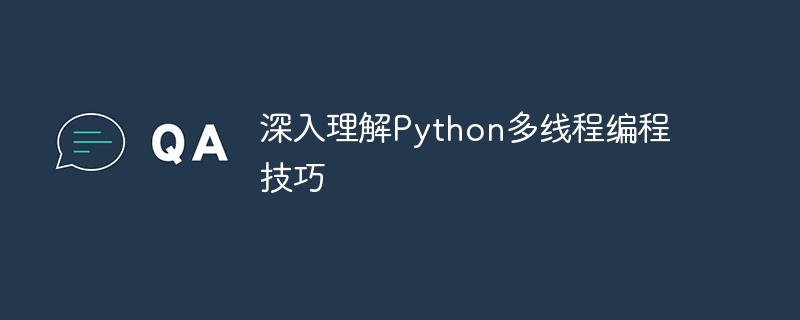Home >Backend Development >Python Tutorial >Deeply master Python multi-threaded programming skills
Deeply master Python multi-threaded programming skills
- 王林Original
- 2024-01-13 12:05:191090browse

In-depth understanding of Python multi-threaded programming skills requires specific code examples
Introduction:
With the continuous improvement of computer performance, multi-threaded programming is in daily development The application is becoming more and more widespread. As a high-level programming language, Python also provides rich multi-threaded programming support. This article aims to help readers deeply understand the techniques of Python multi-threaded programming, and will deepen their understanding of multi-threaded programming through specific code examples.
1. Preliminary understanding of multi-threaded programming
- What is multi-threaded programming?
Multi-threaded programming refers to using multiple threads in a process to perform multiple tasks. In multi-threaded programming, each thread can execute concurrently, thereby improving the running efficiency of the program. - The difference between threads and processes
Threads are the smallest units that the operating system can perform computing scheduling, while processes are the basic units for resource allocation and scheduling by the system. A process can contain multiple threads, and the resources in the process are shared between threads.
2. Basic concepts of Python multi-threaded programming
- Creating threads
In Python, we can use the threading module to create threads. The following is a basic sample code to create a thread:
import threading
def worker():
# 线程具体执行的任务
print("Worker thread")
# 创建线程
thread = threading.Thread(target=worker)- Start the thread
After creating the thread, we need to start the thread by calling the start() method. The following is a sample code to start a thread:
import threading
def worker():
# 线程具体执行的任务
print("Worker thread")
# 创建线程
thread = threading.Thread(target=worker)
# 启动线程
thread.start()- Waiting for the thread to end
If you want to wait for the thread to finish executing before continuing to execute the main thread, we can use the join() method. The following is a sample code that waits for the thread to end:
import threading
def worker():
# 线程具体执行的任务
print("Worker thread")
# 创建线程
thread = threading.Thread(target=worker)
# 启动线程
thread.start()
# 等待线程结束
thread.join()
print("Main thread")3. Advanced skills in Python multi-threaded programming
- Inter-thread communication
In multi-threaded programming , threads need to exchange information and access shared resources. Python provides a variety of communication methods between threads, such as using Queue to transfer information between threads. The following is a sample code for inter-thread communication:
import threading
import queue
def worker(q):
# 线程具体执行的任务
data = q.get()
print("Worker thread: {}".format(data))
# 创建队列
q = queue.Queue()
# 创建线程
thread = threading.Thread(target=worker, args=(q,))
# 启动线程
thread.start()
# 向队列发送数据
q.put("Hello from main thread")
# 等待线程结束
thread.join()
print("Main thread")- Thread synchronization
In multi-thread programming, in order to avoid the problem of data inconsistency caused by multiple threads accessing shared resources at the same time, we Need to use thread synchronization mechanism. Python provides a variety of thread synchronization methods, such as using Lock to achieve mutually exclusive access by multiple threads. The following is a sample code for thread synchronization:
import threading
# 创建锁
lock = threading.Lock()
def worker():
# 线程具体执行的任务
lock.acquire()
try:
print("Worker thread")
finally:
lock.release()
# 创建线程
thread = threading.Thread(target=worker)
# 启动线程
thread.start()
# 等待线程结束
thread.join()
print("Main thread") IV. Summary
This article introduces the basic concepts and advanced skills of Python multi-thread programming, and explains multi-threading through specific code examples. Practical applications of programming. In actual development, multi-thread programming can make full use of the computer's multi-core resources and improve the running efficiency of the program. However, it should be noted that multi-threaded programming has problems such as thread safety and race conditions. We need to use thread synchronization mechanism reasonably to solve these problems. I hope this article can help readers better understand and use Python multi-threaded programming techniques.
The above is the detailed content of Deeply master Python multi-threaded programming skills. For more information, please follow other related articles on the PHP Chinese website!
Related articles
See more- How to find factorial in python
- Practical Word tips to share: Quickly replace English quotation marks with Chinese quotation marks
- Practical Word Tips Sharing: 4 Ways to Update Table of Contents
- Practical Excel skills sharing: Four methods for summing across worksheets
- Several ways to implement multithreading in java

